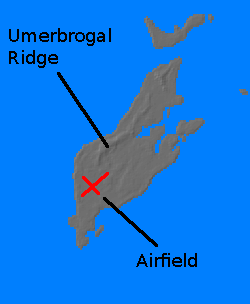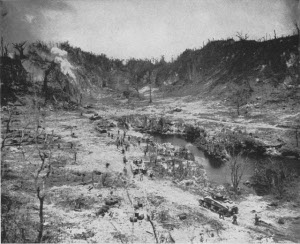

U.S. Marine Corps. Via ibiblio.org
 |
U.S. Marine Corps. Via ibiblio.org |
Peleliu (134.23E
6.995N) is a small island in the Palau
group. It is about 6 miles (10km) long and two miles (3 km) across. Its southern half
is relatively flat and protected by coral reefs,
which made it a good
site for
a military airfield to protect
the nearby Kossol Anchorage. Its northern half is
dominated by the Umerbrogal
Ridge, a 300' (90m)
coral formation, which was heavily fortified by the Japanese
during the
war. The whole island was covered in dense jungle, and much of its coastline was mangrove swamp.
The Japanese had built an airfield on the southern
half of the island by the time war broke out in the Pacific. They also
constructed a road network that included roads along both the east and
west sides of Umerbrogal Ridge. The island produced small amounts of phosphate that were refined at Akaraoro Point, the northeastern tip of the island.
The Japanese sited most of their beach defenses along the southwest
coast, which they correctly guessed would be the location of any Allied landing, since the reef here
narrowed to 600-700 yards (550-640 meter) wide. However, the majority
of the Japanese defenders were dug in at Umerbrogal Ridge.
The Peleliu campaign was one of the bloodiest
campaigns of the Pacific War. It did not help that the campaign was
poorly planned and implemented. No American had ever set foot on the
island, and the heavy jungle foiled
aerial photoreconnaissance,
concealing the jagged ridges
dominating the airfield. The main assault force, 1
Marine Division (Rupertus), was exhausted from earlier tough campaigns, its
ranks filled out with green recruits who could not be properly trained at its primitive base camp
in the Russell Islands.
The size of the Japanese garrison was grossly underestimated (it was
about 5300 combat troops built
around 2 Regiment plus a battalion from 54 Independent Mixed Brigade, another battalion, and a company of tanks, and 5000 service troops) and planning
was almost
perfunctory.
An underwater demolition
team brought in by submarine
Burrfish
reconnoitered the beaches on
13 August 1944. Four men of the team later went missing while
reconnoitering Yap.
Preliminary bombardment of Peleliu began on 12
September 1944. The bombardment group consisted on five battleships, five heavy cruisers, four light cruisers, and 14 destroyers under Oldendorf, with air cover
provided by a number of escort
carriers
under Ralph Ofstie.
Distant cover was provided by a fast carrier division under William Sample. Meanwhile
UDTs cleared coral heads and obstacles and minesweepers swept the waters
around Peleliu.
Elements of 1 Marine
Division began landing on the
15th in LVTs. Tanks were brought
in on LCTs launched from LSDs. The Marines
quickly overran the
jungle terrain in the south, but the attack
on the airfield led to the second largest tank battle of the Pacific
War. About 13 Japanese light tanks with infantry counterattacked and were
annihilated by American tanks, artillery,
and bazooka teams. The Marines
then carried out a charge
over open ground that many participants considered the worst fire fight
of
the war. However, optimism remained unduly high, and by 17 September Wilkinson concluded that
81 Division,
the floating reserve, would not be needed on Peleliu and sent it to
take Angaur instead. By this time
aircraft were beginning to land on the airfield (11 Marine Air Group
would be based there by 1 October and a 6000' [1830m] bomber strip completed a week later.)
In fact, it took another two months to neutralize
the fortifications in
the
Umerbrogal
Ridge. For the first time since Guadalcanal,
the Japanese neither made a stand on the beach nor wasted themselves in
hopeless banzai charges. Instead, they
remained inside their
fortifications by day and carefully rationed their fire, seeking to
kill as
many
Allied soldiers as possible
before each position was reduced. At night, small parties of Japanese
infiltrated the Marine lines, keeping the Americans on edge. Leaving
the Japanese in the ridge to their own devices was not an option, as
several of the cave fortifications overlooked the airfield.
The fortifications were nearly impenetrable. Marines on the surface could smell Japanese fish and rice cooking in the caves beneath them. On 27 September the Marines encountered a cave containing a thousand defenders. Reduction of the defenses was possible only by the use of the new flamethrower tanks, which allowed the Americans to burn out the defenders a few at a time.
On 28 September a battalion of 5 Marine Regiment crossed from Peleliu to Ngesebus in LVTs to seize
the airstrip and eliminate artillery fire from high ground north of the
airstrip. The assault was preceded by an hour of bombardment and air
strikes by Corsairs that allowed the battalion to get ashore without a
single casualty. By 1500 the airstrip and most of the island had been
overrun at the cost of 28 Marine casualties, but stubborn resistance
continued in the remaining high ground of Ngesebus. Japanese losses
were 440 dead and 23 taken prisoner. Although Rupert declared the island secured on 30 September, Army troops continued mopping up for some time.
Rupertus seemed determined to complete the conquest of Peleliu using his Marines alone, and it took a direct order from Geiger to get Rupertus to bring in fresh troops from 81 Division on 22 September to relieve the battered 1 Marine Regiment. Sloan (2005) suggests that Rupertus' attitude was a reflection of his poor health (he died a few months later from a heart attack) and his knowledge that this would be his last campaign.
The assault phase was declared complete on 12
October, but mopping up
took another six weeks, with the last organized resistance ending with
a banzai charge on the night
of 24-25 November and the suicide
of the garrison commander. One measure of the viciousness of the
campaign is that the Marines employed 16,000 hand grenades in six weeks of combat. Total casualties were 1,794 Americans killed and 8,010 wounded and 10,695 Japanese killed and 202 taken prisoner.
Tragically, this campaign was
probably unnecessary. Though
the Palaus were theoretically well placed to attack the flank of MacArthur’s
drive on the Philippines,
by this point in the war the Japanese lacked the shipping and air power
to
maintain the islands even if they had not been taken. However, Nimitz did not feel he had
the authority to cancel the operation without first consulting the
Joint Chiefs of Staff, and Sutherland,
MacArthur's chief of
staff, argued for the operation. (MacArthur was already embarked for
the Philippines and did not break radio silence.)
References
The Pacific War Online Encyclopedia © 2007, 2009-2011 by Kent G. Budge. Index